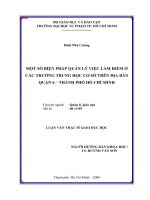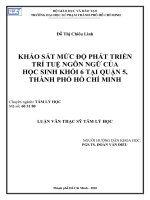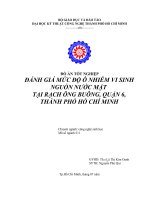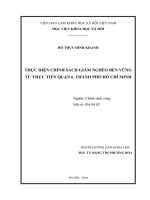Lecture Web technologies and programming – Lecture 6: Introduction to HTML - TRƯỜNG CÁN BỘ QUẢN LÝ GIÁO DỤC THÀNH PHỐ HỒ CHÍ MINH
Bạn đang xem bản rút gọn của tài liệu. Xem và tải ngay bản đầy đủ của tài liệu tại đây (612.56 KB, 10 trang )
<span class='text_page_counter'>(1)</span><div class='page_container' data-page=1></div>
<span class='text_page_counter'>(2)</span><div class='page_container' data-page=2>
2
<b>Modeling web </b>
</div>
<span class='text_page_counter'>(3)</span><div class='page_container' data-page=3></div>
<span class='text_page_counter'>(4)</span><div class='page_container' data-page=4>
• <b>Software system architecture</b>
• <b>Specifics of web application </b>
<b>architecture</b>
• <b>Layered web architecture</b>
– <b>2-layered architecture</b>
– <b>3-layered architecture</b>
– <b>N-layered architecture</b>
</div>
<span class='text_page_counter'>(5)</span><div class='page_container' data-page=5>
• <b>Introduction to HTML</b>
• <b>Basic Structure of a HTML page</b>
• <b>Text formatting tags in HTML</b>
</div>
<span class='text_page_counter'>(6)</span><div class='page_container' data-page=6>
• HTML – <b>Hyper-Text Markup Language </b>–
The Language of Web Pages on the
World Wide Web
• <b>Hypertext:</b>
– Allows for non-linear linking to other
documents
• <b>Markup Language:</b>
– Content is “marked up” or tagged to tell the
browser how to display it
</div>
<span class='text_page_counter'>(7)</span><div class='page_container' data-page=7>
• It is called markup language because it
contains a set of markup tags
• <b>HTML is a text formatting language</b>
• HTML standards are developed under the
authority of the World Wide Web
Consortium (W3C), headed by Tim Lee
</div>
<span class='text_page_counter'>(8)</span><div class='page_container' data-page=8>
• It defines the <b>structure</b> of webpages and
<b>determines</b> how data is displayed online
• It has a set of special instructions that can
be added in the text to add <b>formatting</b>
and <b>linking information</b>
• It is directly interpreted by the <b>browser</b>
• HTML is described by different<b> HTML tags</b>
• Each HTML tag <b>describes</b> different
document content
</div>
<span class='text_page_counter'>(9)</span><div class='page_container' data-page=9>
• HTML was created in <b>1991</b> by <b>Tim </b>
<b>Berners-Lee </b>at CERN in Switzerland
• It was designed to allow scientists to
display and share their research
• <b>1995- HTML 2</b>
• lots of browsers had added their own bits
to HTML
• <b>Dan Connolly </b>and colleagues collected
</div>
<span class='text_page_counter'>(10)</span><div class='page_container' data-page=10>
• <b>1997- HTML 3.2</b>
• It was the first version developed and
standardized exclusively by the W3C
• HTML 3.2 included the support for
<b>applets</b>, <b>text flow around images</b>,
<b>subscripts</b> and <b>superscripts etc </b>
• <b>1999 – HTML 4.1</b>
• extends HTML with mechanisms for <b>style </b>
<b>sheets</b>, <b>scripting</b>, <b>frames </b>etc.
• <b>HTML5</b>
</div>
<!--links-->









